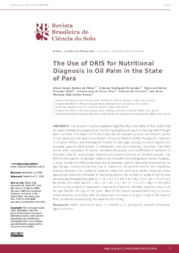The use of DRIS for nutritional diagnosis in oil palm in the State of Pará.
The use of DRIS for nutritional diagnosis in oil palm in the State of Pará.
Author(s): MATOS, G. S. B. de; FERNANDES, A. R.; WADT, P. G. S.; PINA, A. J. de A.; FRANZINI, V. I.; RAMOS, H. M. N.
Summary: The oil palm crop has expanded significantly in the state of Pará, which has not been followed in a proportional manner by studies aiming at increasing yield through plant nutrition. The objective of this study was to evaluate general and specific norms of the Diagnosis and Recommendation Integrated System (DRIS) for genetic materials of oil palm (African and interspecific hybrid) at two ages (young and adult plants) and evaluate possible deficiencies in fertilization and soil correction practices. The DRIS norms were composed of means, standard deviations, and coefficients of variation of bivariate, specific, and general relationships among nutrients of 144 leaf samples. The DRIS norms specific for genetic material did not differ from the general norms; however, a large number of differences were found between specific bivariate relationships for age groups, among themselves, and in relation to the general norms. The regression analysis between the nutritional balance index and yield were better explained when age groups were discriminated. In the young plants, the number of cases of stands with deficiencies followed the order Ca > Fe > B > S > Mn > K > Mg = Cu > Zn > N > P; and for adults, this order was Ca > Mn > Zn > Fe > S = B > N = Cu > K > Mg > P. The DRIS norms can be utilized in diagnostics regardless of genetic material; however, they must be specified for the age of the plant. Most of the stands showed deficiency in Ca and micronutrients, coinciding with the least used nutrients in oil palm crops in the state of Pará, as well as emphasizing the need for soil liming.
Publication year: 2017
Types of publication: Journal article
Unit: Embrapa Eastern Amazon
Observation
Some of Embrapa's publications are published as ePub files. To read them, use or download one of the following free software options to your computer or mobile device. Android: Google Play Books; IOS: iBooks; Windows and Linux: Calibre.
Access other publications
Access the Agricultural Research Database (BDPA) to consult Embrapa's full library collection and records.
Visit Embrapa Bookstore to purchase books and other publications sold by Embrapa.

